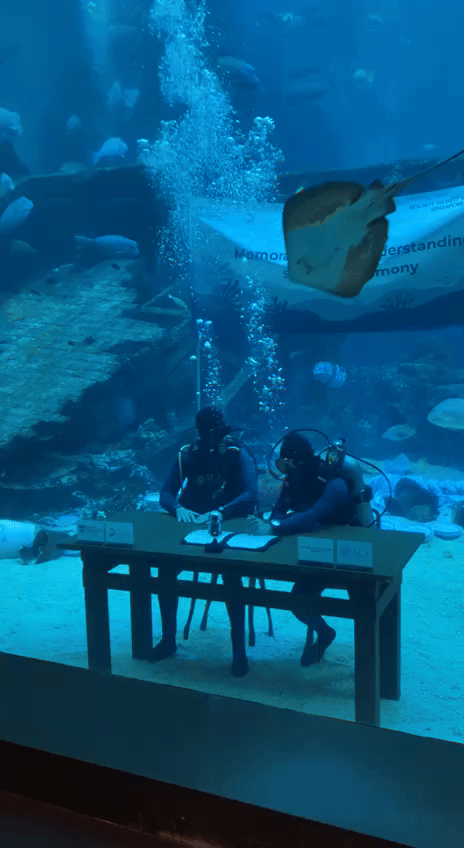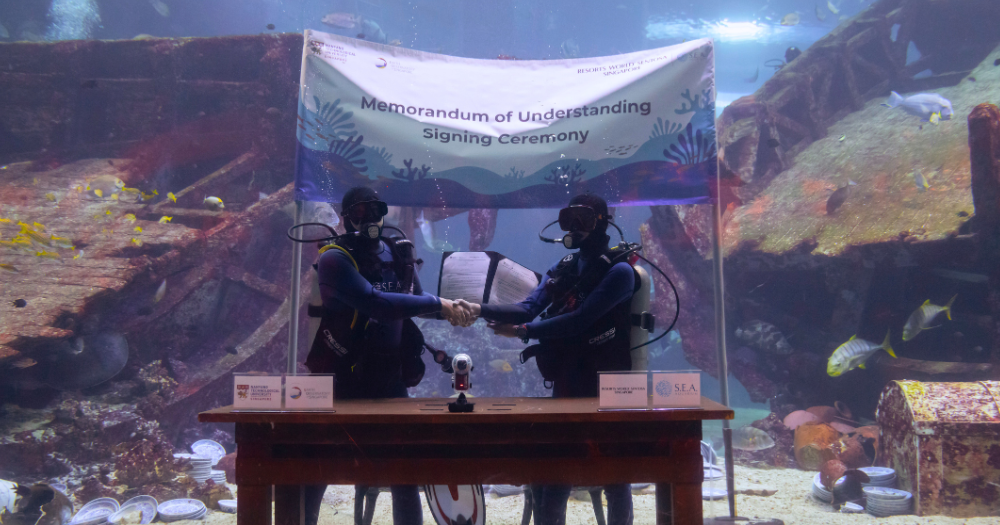Resorts World Sentosa’s (RWS) S.E.A. Aquarium and the Earth Observatory of Singapore (EOS) at Nanyang Technological University (NTU) signed an agreement for a research collaboration on Apr. 30, 2024.
Uniquely, the signing was done underwater.
NTU assistant professor Kyle Morgan, and Abel Yeo from S.E.A. Aquarium’s Education, Research & Conservation team, dove into S.E.A. Aquarium’s Shipwreck Habitat to sign the memorandum of understanding (MOU).
There was a table and two chairs set up on the floor bed of the tank. The pair swam into place and took their seats, before signing the MOU as stingrays cruised past:
 GIF from Tharun Suresh.
GIF from Tharun Suresh.
EOS was created in 2008 to research natural disasters and climate change in and around Southeast Asia. It is interested in how cities in Singapore and Southeast Asia can better understand and prepare for natural calamities and climate change.
S.E.A. Aquarium and EOS are set to collaborate on several research projects, public outreach programs and educational activities.
The collaboration aims to bring together the expertise and resources of both S.E.A. Aquarium and EOS "to help address the urgent global crisis of climate change".
 Photo from Resorts World Sentosa
Photo from Resorts World Sentosa
Joint research projects on super corals
Shortly after the signing, Mothership asked Benjamin Horton, director of NTU-EOS and Professor at NTU's Asian School of the Environment, how the partnership will allow the institute to make better use of the S.E.A. Aquarium's facilities and resources.
“Well, just look”, Benjamin said as he gestured at the tank behind him where the MOU had just been signed, florid with marine life. “This is an amazing laboratory", he added.
Horton told Mothership that the aquarium will enable EOS to pursue special joint research projects on topics like super corals.
Super corals are corals that can better withstand higher temperatures and other stressors in the environment.
He explained that understanding super corals, such as those in Singapore, can provide us with valuable insights into solving coral bleaching due to climate change.
"Just observing a species is understanding its genetic code. What is it in its DNA that makes the corals of Singapore resistant to heat, while the corals of the Great Barrier Reef are not? If you can find that solution, and you understand how to breed them, how to grow them, you can plant them everywhere in the world and solve the problem," Horton added.
He also noted that saving coral reefs is a vital part of tackling the climate crisis.
"When we think about solving climate change, there are two things you need to do. One is reduce your emissions. And the second is save the natural world and save your corals," he told Mothership.
Sensors to monitor sea levels
EOS also plans on deploying Global Navigation Satellite System (GNSS) stations around the S.E.A. Aquarium to monitor sea temperatures and levels.
Leong Choong Yew, Director for the Centre for Geohazard Observations at EOS, told Mothership that the GNSS stations use "reflected signals" from the sea surface to measure sea levels.
The coastal location at the S.E.A. Aquarium, moreover, provides EOS with a "perfect opportunity" to better examine sea levels, Leong added.
The stations will help scientists and researchers gather information about the weather too.
For instance, the GNSS stations at RWS also allow EOS to measure atmospheric water vapour levels above the sea. Leong noted that such data can provide EOS with meteorological insights such as when and how thunderstorms might form over Singapore.
Educational opportunities
Horton also told Mothership that the S.E.A. Aquarium's facilities also provide students with a convenient and accessible field site where they can learn about marine life. "You don't travel around the world, you just need to get to Sentosa," he added.
For instance, the Rainbow Reef, a snorkelling spot at Adventure Cove Waterpark, is set to be used as a teaching facility for NTU students.
It will give students a safe and accessible space to familiarise themselves with field equipment and test it out, before moving to foreign waters.
Benjamin Horton also spoke of internship opportunities for students in their third or fourth year at NTU's Asian School of the Environment to work at the aquarium and spend up to "eight hours a day underneath the water".
Engaging the broader public
The partnership will also allow EOS to engage the broader public on the marine research that the institute is conducting, as well as climate issues.
Horton told Mothership that EOS wants to take advantage of the partnership to communicate to the public how "increasing heat is going to affect all the marine life that you see" at the aquarium.
He added that the goal is also to assuage "climate anxiety" and let people know that there are indeed solutions to the crisis, such as the research done by EOS on super corals.
Nicholas Derbyshire, Director of Visitor Experience at S.E.A. Aquarium/Dolphin Island provided a teaser of some of the outreach programs in store at S.E.A. Aquarium.
"Through interactive exhibits, online education series, animated characters, and podcasts, the collaboration between EOS and S.E.A. Aquarium will actively engage the public and stakeholders to deepen their understanding of green science and climate change," Nicholas said.
Top photo from Resorts World Sentosa.
If you like what you read, follow us on Facebook, Instagram, Twitter and Telegram to get the latest updates.



